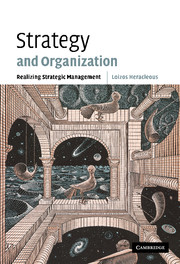Book contents
- Frontmatter
- Contents
- List of figures
- List of tables
- Preface
- I Bases of strategic management
- 1 The strategic management field
- 2 An organizational action view of strategic management
- 3 Strategic thinking or strategic planning?
- 4 Leadership research and the board of directors
- II Realizing strategy
- III Current themes and applications
- Index of names
- Index of subjects
- References
3 - Strategic thinking or strategic planning?
Published online by Cambridge University Press: 11 May 2010
- Frontmatter
- Contents
- List of figures
- List of tables
- Preface
- I Bases of strategic management
- 1 The strategic management field
- 2 An organizational action view of strategic management
- 3 Strategic thinking or strategic planning?
- 4 Leadership research and the board of directors
- II Realizing strategy
- III Current themes and applications
- Index of names
- Index of subjects
- References
Summary
In the early 1980s Henry Mintzberg argued that the meaning of the term “strategic planning” was ambiguous, and that there was a need for a clear understanding of that term (Mintzberg 1981). Now not only is “strategic planning” still used in a variety of ways, but the situation is made even more complicated by the introduction of a more recent term, “strategic thinking.”
The relationship between strategic planning and strategic thinking is by no means clear in the literature, which has been in a state of confusion over this issue. “Strategic planning” is often used to refer to a programmatic, analytical thought process, and “strategic thinking” to refer to a creative, divergent thought process. The confusion, however, stems from the fact that although there are frequent usages of the terms in the above ways, various authors still use these terms in fundamentally different ways. While for some, such as Mintzberg, strategic thinking and planning are distinct thinking modes which are both useful at different stages of the strategic management process, for others, such as Michael Porter, strategic thinking is not so much creative as analytical. For some strategic planning has remained an analytical activity but the organizational practices surrounding it have been transformed; for others the real purpose of analytical tools of strategic planning is to facilitate creativity and strategic thinking; and for yet others strategic planning is useless in a fast-moving world and should be scrapped in favor of strategic thinking.
- Type
- Chapter
- Information
- Strategy and OrganizationRealizing Strategic Management, pp. 38 - 52Publisher: Cambridge University PressPrint publication year: 2003



